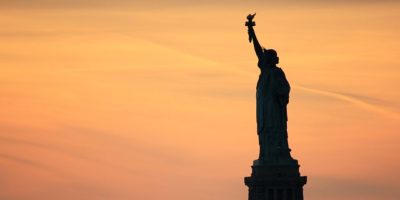When Nancy Met Emma
The story behind the Emma Lazarus museum exhibit
It was the photograph of Emma Lazarus with Persian-lamb muff, fashionable pillbox hat and elegant fur-trimmed jacket that ignited the passion in Nancy R. Savin that ultimately led to the exhibition on Lazarus now at the Museum of Jewish Heritage in New York.
Savin, a long-time arts producer and host for Connecticut Public Television, whose other roles include the presidency of the New England Hebrew Farmers of the Emanuel Society, first saw the photo in Bette Roth Young’s 1995 biography Emma Lazarus in Her World: Life and Letters. Young had discovered a trove of Emma Lazarus letters that, like the photo, recast Emma. She was not just the “give me your tired, your poor” poet but a social reformer who was also a sensual and exuberant young woman very much part of 19th century New York’s Gilded Age artistic salon society. Emma Lazarus, the 2006 biography by Esther Schor, poet and professor of English literature at Princeton, added more fuel to Savin’s determination to pay proper public tribute to Emma.
But it took Savin 14 years to find a museum for her vision of an Emma Lazarus exhibition. Along the way, she produced the 1999 Emma Lazarus Day, celebrating the 150th anniversary of the poet’s birth. The event included the placement of a commemorative plaque on the Lazarus family brownstone on West 10th Street in Manhattan’s Greenwich Village. This is where Emma penned “The New Colossus” in 1883 and where she died four years later, at the age of 38.
Savin’s hits and misses at four museums finally ended in success when she approached the Museum of Jewish Heritage, with its harbor view of the Statue of Liberty. Savin pegged her pitch to the 125th anniversary of the statue, which was approaching in October 2011. The museum’s executive director, David Marwell, liked the idea, and Melissa Martens curated the exhibition “Emma Lazarus: Poet of Exiles,” which opened just in time for the anniversary.
The detailed exhibition, short on pizzazz but long on exquisite details, rewards the unhurried visitor. Emma’s credentials as a member of America’s Sephardic Jewish elite are exhibited, back to her great-great uncle Moses Mendes Seixas, whose letter to George Washington is on loan from the Library of Congress. Seixas’s praise of the government “which to bigotry gives no sanction, to persecution no assistance” became Washington’s best-known statement on religious liberty. Emma’s impassioned concern for welcoming the downtrodden fit right into this illustrious family history.
With documents, family treasures, portraits and Emma’s own words, the exhibition recreates her development from precocious child (born in 1849, the fourth of seven children — six girls and one boy) to salon regular to established writer and social activist increasingly concerned with Jewish issues. Her father was a successful banker who had been a sugar manufacturer, in partnership with a Louisiana slaveholder. Emma was the outsider-insider, a privileged young woman with a social conscience. When her father published her teenage poetry, the book was her calling card to Ralph Waldo Emerson, who became her mentor.
Not religious, her Friday night ritual was the salon at the home of Richard and Helena de Kay Gilder, whose three-story former carriage house had been redesigned by Stanford White. But Emma was still “the Jewess” in this enlightened society.
The exhibition does not dwell on Emma’s thoughts as an unmarried female, though it does touch on her possible attraction to the brother of Helena de Kay Gilder. No mention is made of her long-unpublished poem, in Schor’s biography, of waking from a dream with a woman’s kiss on her lips.
This exhibition builds on the nexus of events and ideas shaping Emma as writer and activist — the 1881 pogroms in Russia, Emma’s first-hand observation of the grim conditions facing desperate Russian Jewish immigrants on Ward’s Island, her attempts to raise funds to settle Eastern European Jews in Palestine long before the Zionist movement, and, finally, in 1883, her writing “The American Colossus” to raise funds for the pedestal of the Statue of Liberty. She was the first to make the connection: not Liberty as a mighty goddess protecting America from the onslaught of foreigners, but “Mother of Exiles,” extending a “world-wide welcome.”
Emma may never have seen the statue. Her poem was absent from the celebration dedicating the Statue of Liberty in 1886. It wasn’t until 1903, thanks to influential friends, that Emma Lazarus’s now famous poem was finally united with the statue.
Revisiting the exhibition, Savin pronounced herself “thrilled that Emma has received a just public tribute.” Ironically, the picture that started it all — Emma with Persian-lamb muff — is absent from the show.
Amy Stone is a founding mother of Lilith.
“Emma Lazarus Poet of Exiles” is at New York’s Museum of Jewish Heritage through December 2012. The museum’s walking tour of Emma Lazarus’s New York is available for iPhone and Android.


